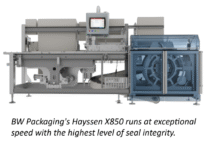Honey is known to be a healthy alternative to sugar, due to its abundant nutrients are proven to boost the immune system. For this reason, honey sales have increased worldwide during the Covid-19 pandemic. As honey manufacturers grow and improve their extraction process, choosing the right packaging and closure has become a key decision. There are three main factors of choosing a closure for a honey product.
Promote quality and freshness
Honey closures need to be composed of food compliant materials, like PET, PP, or PE to reduce contamination. Although honey has a long shelf life, the product can still become crystallized or oxidized over time. To help avoid this, it is key that the closure is airtight. Pairing a tightly sealed closure with Aptar’s SimpliSqueeze could further promote product freshness, by limiting the amount of air and moisture that get inside the bottle.
Enhance consumer convenience and satisfaction
Consumers are always looking for convenient and clean packaging. Many of Aptar’s products feature an easy-open closure, spill-resistant valve, large finger recess, and robust hinge – all features which can help honey manufacturers enhance their consumer experience. A good closure should also be a broad base for inverted packaging, which allows consumers to store the package in a more easily accessible way and promotes less food waste.

Stand out on store shelves
Beyond product freshness and consumer satisfaction, a package also needs to match a brand’s identity and catch the consumers. The features of Aptar’s closures, such as Royal’s bi-injection capability, Dolce’s unique shape, and Tab Top’s ergonomic design, all help to bring differentiation to the store shelves.
As a global leader in dispensing solutions, Aptar Food + Beverage has designed and manufactured a wide range of closures for the honey market, and is ready to help with all of your packaging needs!
IndiFoodBev — authentic, impactful and influential
An English-language food and beverage processing and packaging industry B2B platform in print and web, IndiFoodBev is in its third year of publication. It is said that the Indian food and beverage industries represent approximately US$ 900 billion in revenues which implies more than 20% of the country’s GDP. Eliminating the wastage on the farmside can help to deliver more protein to a higher number of the population apart from generating sizable exports. The savings in soil, seeds, water, fertilizer, energy and ultimately food and nutrition could be the most immense contribution that country is poised to make to the moderation of climate change.
To improve your marketing and grow sales to the food and beverage processing and packaging industry, talk to us. Our research and consulting company IppStar [www.ippstar.org] can assess your potential and addressable markets in light of the competition. We can discuss marketing, communication, and sales strategies for market entry and growth.
Suppliers and service providers with a strategy and budget for targeted marketing can discuss using our hybrid print, web, video, and social media channels to create brand recognition linked to market relevance. Our technical writers are ready to meet you and your customers for content.
The second largest producer of fruit and vegetables in the world is continuously expanding processing capacities and delivery systems with appropriate innovative technologies. We cover product and consumer trends, nutrition, processing, research, equipment and packaging from farm to thali. Get our 2025 media kit and recalibrate your role in this dynamic market. Enhance your visibility and relevance to existing markets and turn potential customers into conversations. Ask for a sample copy of our bi-monthly in print or our weekly IndiFoodBev eZine each Wednesday.
For editorial info@ippgroup.in — for advertisement ads1@ippgroup.in and for subscriptions subscription@ippgroup.in
Naresh Khanna – 10 February 2025
Subscribe Now













honey is highly rich and very nutritious, we have to promote more initiatives to save the bees.